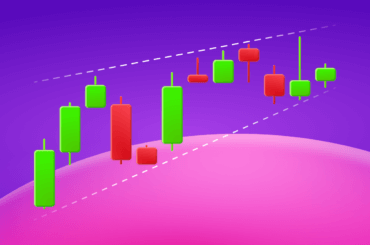Intraday trading brings many opportunities to those who do not wish, or cannot afford to purchase multiple stocks for their portfolio. It works well for many different assets, including Forex pairs, cryptocurrencies and stocks. So, how to day trade stocks and what are the advantages of this approach?
What are the pros and cons of intraday trading on stocks?
One of the most obvious benefits is that intraday traders can follow the price movement of the underlying instrument throughout the trading day through a wide range of technical analysis tools. A wide range of indicators and oscillators are available to help you analyze price movement and take profitable trades. These tools help you enter trades at the right time and exit them at the right time.
Another important advantage is that day trading does not require any high amount of money to open a position and there are no commissions to pay, since the overnight fee doesn’t get charged.
Some of the notable disadvantages of this kind of trading includes increased risks. Though trading is less expensive than the traditional stock exchange, there is still a certain price to be paid for the convenience. The traders also have to learn how to manage their risks appropriately as higher risks always imply higher prices when they come due.
There are several strategies that traders commonly use when day trading. Let’s look at some of them.





Scalping
Scalping is the act of watching price fluctuations very carefully and aggressively seeking out opportunities where even the slightest of price changes can be capitalized for profit. Scalpers’ goal is to make as much profit as possible over numerous deals with small returns. A trader will usually hold onto a trade for between a couple of seconds and several minutes and open several dozens of deals every day.
A popular method used by scalpers is the stop loss order. Most scalpers will set a limit at which they will stop trading if a particular trade goes against them. If the stock price continues to move against them, they will exit their position and minimize their losses. Since most scalpers will set the stop loss at a percentage of the total daily profits, it’s important to follow their strategy precisely. Some traders prefer to leave their stops in place while they’re holding positions, since this strategy allows them to maximize profits while minimizing losses.
News trading
In today’s market, this is a rather self-explanatory term. Traders who practice news trading call themselves “news traders.” The goal of a news trader is to capitalize on newly released information, either breaking news or reports of a stock price. News traders will often react very quickly, depending on the news.
Learning how to use news trading strategy is not something that is incredibly difficult and it is a strategy that has worked for many people over the years. It will work for you too if you are willing to commit some time to learning and researching news that might affect the market.
Swing trading
Swing trading is another strategy that may be considered if you wish to learn how to day trade stocks. By contrast, is more of a long-term trading strategy. This type of trading strategy seeks profits through price fluctuations over a day or more. Traders who practice swing trading generally have an exit strategy and do not pay any attention to the short-term fluctuations. This is the opposite of news trading, since swing trading mainly uses technical analysis. They will often take a position in a stock even if the price may turn against them later, provided they are able to execute the trade quickly and efficiently.
The bottom line
No matter which strategy you choose, learning how to day trade stocks might be a good opportunity to take advantage of the market without committing to a long-term expensive portfolio. Keep the risks in mind and try intraday stock trading on your practice account to see if it suits your approach.



